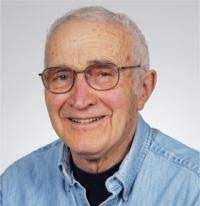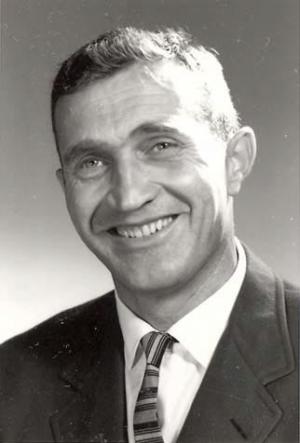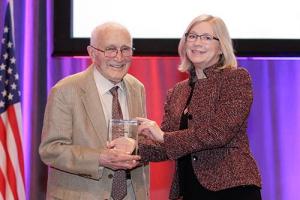
Faculty spotlight: Dr. Stanley Gartler
Dr. Stanley Gartler was born on June 9, 1923, in Los Angeles, California to Romanian immigrant parents. During WWII, he flew combat with the 9th Air Force as a radio operator and machine gunner.
Having an early interest in agriculture, Gartler worked on a farm after earning his undergraduate degree at UCLA and studied genetic plant breeding in graduate school at Berkeley. It was at Berkeley in 1951 when he started to develop an interest in human genetics, after taking a course from an enthusiastic Curt Stern.
Early years
 Gartler started his career in human genetics in 1952 as a fellow at Columbia University, working with German psychiatrist Franz Kallman, who specialized in twin studies.
Gartler started his career in human genetics in 1952 as a fellow at Columbia University, working with German psychiatrist Franz Kallman, who specialized in twin studies.
Two other geneticists at Columbia – L. C. Dunn and Theodosius Dobzhansky – had established an Institute for the Study of Human Variation of which Kallman became a member. Gartler spent most of his research time with Dobzhansky working on urinary amino acid excretion patterns.
Phillip Levine, a well-known student of human red blood cell genetic markers, and Harry Shapiro, a leading American anthropologist, were also active members of the institute.
In 1956, Gartler met Arno Motulsky. Motulsky had gone to medical school in the army and then studied hematology, which led him to genetics.
Hired in 1953 as an instructor at the University of Washington, Motulsky’s enthusiasm for teaching genetics led to his promotion to founding head of a Division Medical Genetics in the Department of Medicine. He offered Gartler the first position in his new division.
It was the only move Gartler would make in his professional life.
University of Washington
Gartler moved to Seattle in 1957; it was the year of “Sputnik”, the first world satellite. Once the American Congress became aware that the Russians were significantly ahead of the U.S. in scientific research, federal research grants were there for the asking and, essentially everybody was funded.
“It was a great time to be a research scientist,” said Gartler.
In 1959, Cal Tech recruited Herschel Roman (a genetics professor in the Department of Botany at the University of Washington) to become Chair of its Biology Division. To keep Roman, the University offered him a Department of Genetics in a new building with research space for Motulsky and Gartler.
This eventually became the UW Department of Genome Sciences.
Pioneering research
"Gartler’s scientific career was one of elegantly designed experiments," said Dr. Gail Jarvik, current head of the Division of Medical Genetics. "He was far ahead of his time in understating the value of collaborations across fields.”
Possibly best known for his work on the X chromosome, one of Gartler’s major research interests was based on the X linked gene, glucose-6-phosphate dehydrogenase [G6PD]. Females have two X chromosomes and males have only one, but most X linked genes, including G6PD, are subject to X chromosome inactivation. That is, even though the female has two X chromosomes, on one of them most of the genes are silent.
David Linder, a visiting pathologist, and Gartler collected material from black women undergoing hysterectomies and identified them by electrophoresis as heterozygotes (A/B) or homozygotes (A/A, B/B). The heterozygotes were analyzed further. Normal appearing tissue of the endometrium was dissected by hand into very small pieces, extracted, and then analyzed by electrophoresis.
They always detected both A and B bands, indicating that both A and B active cells were present in the biopsy. On the other hand, if they analyzed the extract from a tumor, only one electrophoretic pattern was detected, either A or B.
This finding implied that the breakthrough understanding that a tumor must originate from a single cell.
Another of Gartler’s major interests was documenting the cycle of activation and inactivation of the X chromosome in the human oocyte. By studying fetal oocytes, he was able to show that both X chromosomes were active in fetal gonads. He was also able to document the Y linkage of the steroid sulfatase gene to the Y chromosome of the mouse.
The HeLa bomb
Chapter 20 (1966) of the “The Immortal Life of Henrietta Lacks” is about Gartler’s discovery that HeLa cells had contaminated many cell lines thought to be from other tissues.
One of Gartler’s major interests was to establish a somatic cell genetics of human cells. In 1965 he collected 18 what he thought were unique cell lines and checked them for their isozyme type. They were all G6PD A as well as identical at several other independent markers.
They were clearly not independent and detailed study suggested that they were most likely contaminants of HeLa, the first human cell line established by George Gey.
Gartler presented these data at the 1966 national tissue culture association meeting and, recalls Gartler, “quite a few arguments followed.” After the meeting, he says, “I spent a fair amount of time checking out people’s cultures for them.”
“Many papers had to be reinterpreted in this light, said Jarvik. “If you work with cell lines and have had to type them for quality control, you can thank Stan Gartler for that—and for the fact that you are not accidentally studying HeLa cells.”
Honors

Gartler has been president of the American Society of Human Genetics, fellow of the American Association for the Advancement of Science, and a member of the National Academy of Sciences.
In 2016, the American Society of Human Genetics presented him with the Victor A. McKusick Leadership Award from the American Society of Human Genetics.
Stanley Gartler: A Genetic Centenary Reached
updated June 9, 2023
In honor of Dr. Gartler's 100th birthday, a poem by Joseph L. Goldstein, M.D. (with help from ChatGPT-4). Dr. Goldstein is a Medical Genetics alumni who was co-awarded the Nobel Prize in Medicine for the familial cholesterolemia work he began here as a fellow.
In the realm of genetics, a beacon of light,
Stanley Gartler, a scientist shining so bright.
A centenary reached, a moment to celebrate,
A life dedicated to unraveling nature's intricate state.
Among his triumphs, G6PD stood tall,
A gene of significance, unraveling its call.
Stanley delved deep into its X-linked domain,
Understanding its intricacies, forging a new terrain.
With each discovery, his knowledge grew,
Gartler's insights into G6PD, ever true.
Through tireless nights, his experiments took flight,
Unraveling the enigma, bringing it into the light.
A pioneer in genetics, an extraordinary mind,
Stanley Gartler, leaving no question behind.
His work on G6PD, a testament to his might,
Advancing understanding, like a star shining bright.
Today we celebrate a century of his birth,
A milestone attained with grace and worth.
Happy 100th, dear Stanley Gartler, we sing,
May your legacy in genetics forever ring!